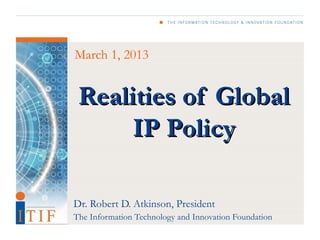
CES-GMU Workshop on Internationalization & Competitiveness
- 1. March 1, 2013 Realities of Global IP Policy Dr. Robert D. Atkinson, President The Information Technology and Innovation Foundation
- 2. The Information Technology and Innovation Foundation (ITIF) is a Washington, D.C.-based think tank at the cutting edge of designing innovation policies and exploring how innovation will create new opportunities to boost economic growth and improve quality of life. ITIF focuses on: Innovation “verticals”: energy, life sciences, telecom, manufacturing, and Internet and IT transformation Innovation “horizontals”: trade, tax, talent, and tech policy “Innovation economics” as an alternative to mainstream economics
- 3. Positions on Global IP Policy Depends on Values and Goals Is the goal to: help people in developing nations regardless of impacts on rest of world? maximize U.S. welfare? maximize global welfare? Advocates have different goals, but seldom do they make them public. 3
- 4. Positions on Global IP Policy Depends on Values and Goals As economist Richard Lipsey notes, “There is nothing in neoclassical welfare economics… to tell us the optimum position on this trade-off” (between IP protection and future innovation and weak IP protection and current consumption). 4
- 5. What’s Missing in the Debate? Neoclassical economics for trade is based on maximizing allocation efficiency by letting comparative advantage reveal itself (e.g., coffee, oil, low wage industries). Innovation Economics support for trade is based on maximizing innovation through competition and attaining scale in low marginal cost, high fixed cost industries. 5
- 6. Most Policymakers Do Not Rely on “Rational Analysis” Predominant view in the development literature is that nations achieve growth through moving up the value chain. In fact, growth comes from productivity and innovation across the board in all industries, not just selected export industries. 6
- 7. The Evidence on IP and Innovation in Developing Nations Perceptions of strong IPR abroad have a positive effect on incentives to transfer technologies abroad. At least 25 percent of American and Japanese high-tech firms refused to direct invest or joint venture in developing countries with weak intellectual property rights. (World Bank’s International Finance Corporation) 7
- 8. The Evidence on IP and Innovation in Developing Nations Strengthening IPR protection has been connected with increased inflows of FDI. (Cavazos, Cepeda, Lippoldt and Senft) Stronger patent rights in developing countries give enterprises from developed countries a greater incentive to research and introduce technologies appropriate to developing countries. Diwan and Rodrik have demonstrated that weak patent rights in developing countries lead enterprises from developed countries to introduce less-than-best IPR practice technologies to developing countries. 8
- 9. The Evidence on IP and Innovation in Developing Nations While IP theft may help countries in the short- run, it stifles incentives to embark on home- grown technology development. Retarding countries’ abilities to develop their long-term capability. Countries in which “uncertainties in the IP environment persist” are “likely to fall short of their innovation potential.” (Grossman and Helpman) 9
- 10. Developed Nations Drive Global Innovation The reality is that developed nations drive innovation, produce the most patents and invest the most in R&D. Developing nations benefit from a strong innovation system in developed nations. We see this in patents for clean energy with the leaders being developed nations. 10
- 11. Clean Energy Patents per Million Residents Rank Country Clean Energy Patents Per Million Residents 1 Denmark 27.04 2 Japan 26.52 3 Sweden 24.45 4 Germany 23.24 5 Norway 21.52 6 Switzerland 19.05 7 Finland 17.70 8 Austria 16.99 9 South Korea 15.37 10 Netherlands 14.78 11 Israel 12.92 12 Singapore 11.00 13 France 10.95 14 United States 8.88 15 Australia 8.49 16 Canada 7.90 17 Iceland 7.43 18 Belgium 7.09 19 United Kingdom 6.06 20 New Zealand 5.21 21 Ireland 4.64 22 Italy 4.26 23 Slovenia 4.23 24 Spain 3.83 25 Luxembourg 3.35 11
- 12. Clean Energy Patents per Million Residents, Cont’d Rank Country Clean Energy Patents Per Million Residents 26 Hungary 1.63 27 Estonia 1.49 28 Czech Republic 1.44 29 Latvia 1.33 30 Slovak Republic 1.11 31 Greece 1.03 32 Poland 0.68 33 Malaysia 0.82 34 Bulgaria 0.75 35 Portugal 0.68 36 Croatia 0.68 37 Romania 0.62 38 Russia 0.48 39 United Arab Emirates 0.43 40 South Africa 0.41 41 China 0.36 42 Chile 0.35 43 Kazakhstan 0.32 44 Chinese Taipei 0.31 45 Ukraine 0.31 46 Tunisia 0.28 47 Turkey 0.26 48 Saudi Arabia 0.22 49 Moldova 0.21 50 Brazil 0.20 Source: Calculated using data from the OECD Patent Database (accessed on June 4, 2012) 12
- 13. Weak IP is an Intentional Strategy Unfortunately, many developing nations use weak IP as a core economic development strategy. This includes: Forced technology transfer weak patent systems cyber-theft industrial espionage 13
- 14. Intellectual Property Rights Indicators Source: The Global Innovation Policy Index, ITIF and the Kauffman Foundation, 2012 14
- 15. Country Ranks for Intellectual Property Rights Protections Source: The Global Innovation Policy Index, ITIF and the Kauffman Foundation, 2012 15
- 16. Thank You Robert D. Atkinson ratkinson@itif.org Follow ITIF: facebook.com/innovationpolicy www.innovationfiles.org www.youtube.com/techpolicy www.itif.org @robatkinsonitif
